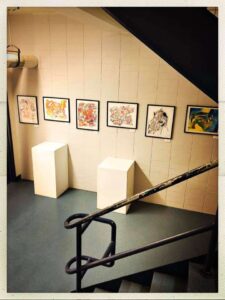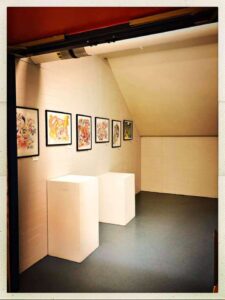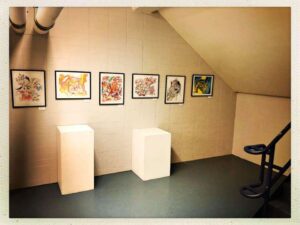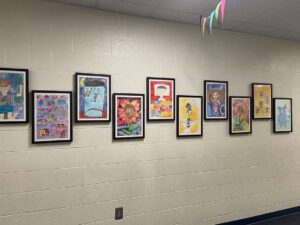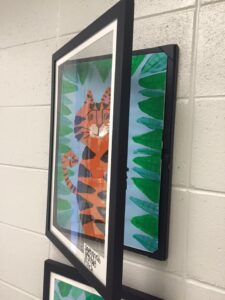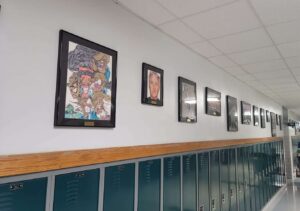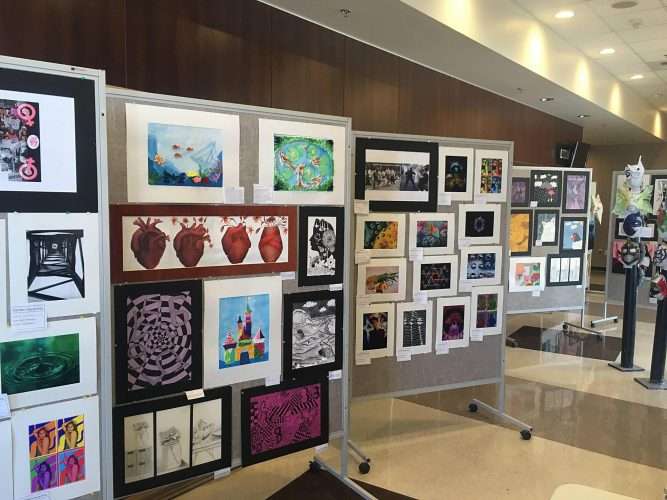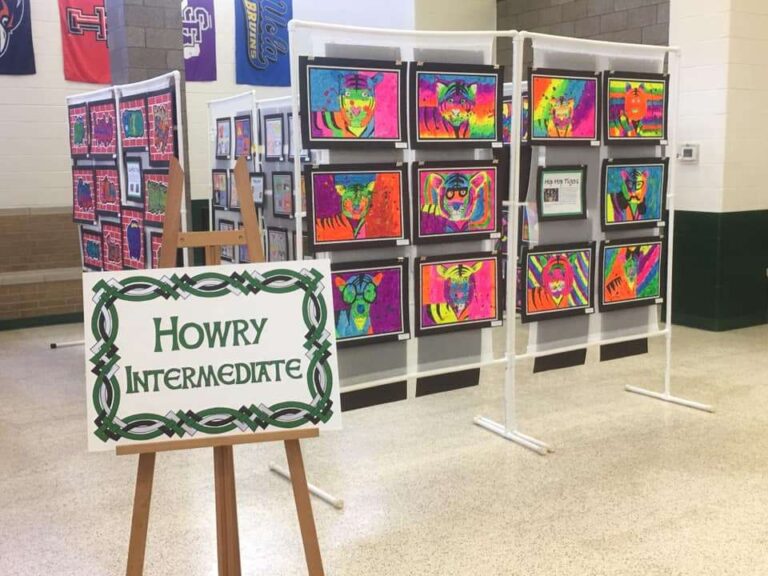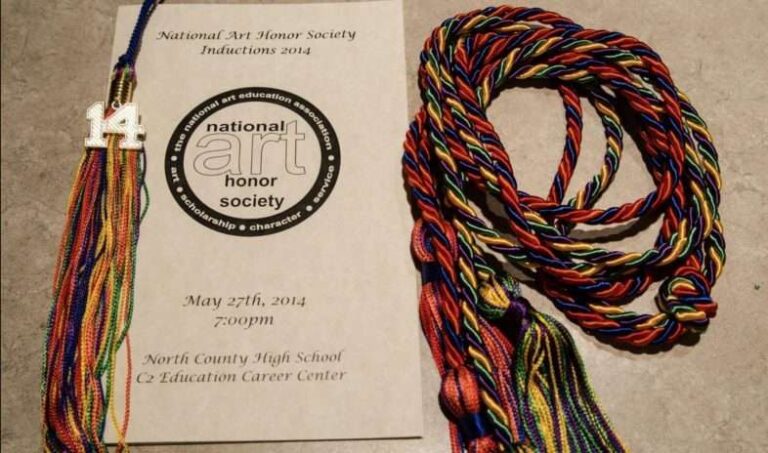One of the things I proudly accomplished as an art teacher and department chair was starting a school gallery. At the time, I had a promising art student who was killed in a car accident. As I struggled to come to terms with her death, I proposed starting an art gallery in her memory. The school had a recent new wing constructed and there was a hallway off of the main lobby that we turned into the gallery space.
My next step was looking into different gallery wall hanging systems. The system I settled on, the Stas Picture Hanging System, worked well for me over the years and I have nothing but good things to say about it and have recommended it to many people over the years. It was also very affordable. Our custodian installed the system and reported it was easy to install. (My custodian actually bought the rail and hangers for his wife for easily changing out family photos.) I purchased simple standard-size black frames from Michaels in a variety of sizes. I found that most mail-order frames came with plexiglass whereas the Michaels frames had real glass, which I preferred. I had a mat cutting system so I could cut custom mats to work with the frames. When working with standard paper sizes, I could often reuse these mats. In addition, the school had a business come in to install the gallery name above the entrance and we hosted a gallery ribbon-cutting ceremony for the opening of the gallery’s first exhibit.
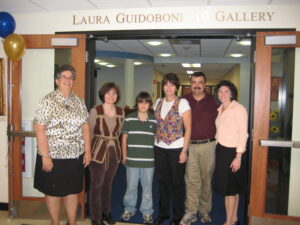
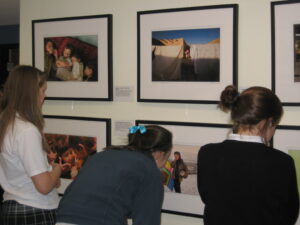 Over the years I oversaw the gallery, it was most often used to display student work but on occasions, we also had displays from alumni, visiting artists, and staff. The gallery hosted an exhibit of a local photojournalist known for using her photography to document the untold stories of women in Afghanistan. This exhibit went along with a One Book, One School program and was arranged by our school librarian. I also coordinated an exhibit of artists with autism on another occasion to also complement a One Book, One School program. Both exhibits were wonderful opportunities to enrich our academic community and make connections to the community through art.
Over the years I oversaw the gallery, it was most often used to display student work but on occasions, we also had displays from alumni, visiting artists, and staff. The gallery hosted an exhibit of a local photojournalist known for using her photography to document the untold stories of women in Afghanistan. This exhibit went along with a One Book, One School program and was arranged by our school librarian. I also coordinated an exhibit of artists with autism on another occasion to also complement a One Book, One School program. Both exhibits were wonderful opportunities to enrich our academic community and make connections to the community through art.
Establishing and maintaining a school art gallery is a great way to develop students’ skills, knowledge, understanding, and appreciation of art while building a sense of pride and ownership in their school. For all these reasons, starting a gallery can be a rewarding experience. If you are considering starting a school gallery, here are some factors to consider.
Space
A school needs to consider where a gallery can be located. Some might integrate it with a library, some might have a separate room, common area, or a hallway to dedicate to it. Like any display in a school safety of the artwork needs to be considered. Another thing to consider is if and how 3-dimensional art would be displayed. Resourceful art teacher John Zilewicz craftily used space under the school’s stairway for a gallery in the photos below.
Another consideration I didn’t think through was storage space for gallery items. I often had frames for the gallery, not in use and they cluttered my classroom. They were getting nicks and scrapes which was not ideal. Eventually, I emptied a classroom closet and bought a metal rack to place in the closet to help store the frames and other miscellaneous gallery equipment.
Costs
Creating a school gallery includes start-up costs and maintenance costs. Consider asking parent-teacher organizations for financial help, they often offer grant opportunities. Start-up costs for my gallery included the investment in the gallery rail system (the rails, rail cords, and hooks), frames, picture hanging wire, matboard, matboard cutter, extra blades, frame bumpers, and gallery labels. Our lighting was adequate but lighting might be something that also needs to be planned for. Through a separate building budget, our administration arranged for signage for the gallery space, see the first picture in the article taken for the gallery’s opening. Every year after starting the gallery I created a line item in our budget for ongoing gallery costs.
Staffing
As a department chair, I had periods off for department and administrative work that allowed me time to work on the gallery. Eventually, down the road, it became a paid position with a title.
I also had an art honor society and the students needed to earn community service hours and helping with the gallery was an opportunity I offered to members. Some students learned how to cut mats, hang work and curate the work. At the end of the school year, our AP students proudly display their work in the gallery and also learned the ins and outs of matting, hanging, and curating their work in the gallery.
Online presence
Your gallery can also exhibit work online. It’s never been easier to take, edit and upload photos. You can use various social media platforms to let the school community know what is happening with the gallery.
Examples of School Galleries
Here are some examples of gallery spaces at private and public schools. From hallway spaces, and legacy collections, to areas designed to be a gallery here is a range of what can exist.
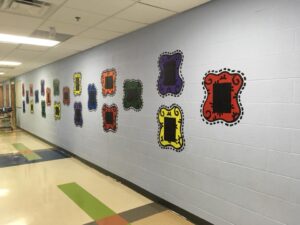 .
. 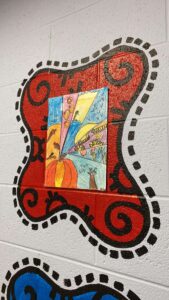
Janet Malona painted these “frames” onto her school’s walls and simply tapes the work in place of the “frames.”
Lyn Paolino’s school planned this gallery space in a building renovation. The walls have a grey corkboard-like material for tacking up the artwork.
Libby McArthur’s school buys select work from seniors to display around the school as seen above.
And you can see the Foster Gallery which is located at Noble & Greenough School, a private school in Dedham MA.
From their website:
“Foster Gallery is committed to acting as a classroom that explores the fundamental importance of visual literacy by grappling with issues of identity and in engaging in critical conversations about artwork and the world views expressed by artists and community members. The Visual Arts Department of Noble and Greenough School curates educational experiences in Foster Gallery, inspired by the ever-changing needs of the community and designed to inform, engage, and challenge. Foster Gallery aspires to provide a place of discovery, reflection, and respectful discourse—seeking to not only be a safe space but a brave one.”

